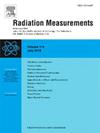用于伽马发射源定位的双探测器阵列的定向容量
IF 2.2
3区 物理与天体物理
Q2 NUCLEAR SCIENCE & TECHNOLOGY
引用次数: 0
摘要
对涉及放射性物质的事件作出反应时,确定源头的能力对于有效、高效的反应至关重要。在这种情况下,探测系统的定向响应是很重要的。目前用于源定位的许多解决方案涉及的方法在成本、复杂性和现场操作的实用性方面可能是繁重的。为了避免这些缺点,开发了一种基于同时使用两个伽马探测器(2 × 1阵列)的方法。建立了简单的数学模型来处理相邻两个检测器检测到的计数率。该模型的参数主要取决于探测器的设计,因此可以从图纸中得出。对于大型探测器,方向估计的能量依赖性可以忽略不计。该方法可以适用于小型手持系统,也不需要复杂的校准或数据处理。利用蒙特卡罗方法和受控条件下的实际测量证实了几个2 × 1阵列的方向响应,这些阵列是由市售的现成探测器构建的。描述并分析了在探测器之间使用屏蔽的优化策略和性能约束。结果表明,多种探测器类型和尺寸的2 × 1阵列可以在180°视场范围内提供源方向的函数估计。本文章由计算机程序翻译,如有差异,请以英文原文为准。
Directional capacity of a two detector array for localization of gamma emitting sources
Capacities for source localization in response to incidents involving radioactive materials are essential for effective, efficient response. In this context, the directional response of a detection system is of importance. Many solutions currently employed for source localization involve approaches that may be onerous with respect to cost, complexity and practicality for field operations. To avoid these drawbacks, an approached was developed based on simultaneous use of two gamma detectors (2 x 1 array). Simple mathematical models were developed to cope with the count rate detected by two adjacent detectors. The parameters of the model depend mainly on the design of the detectors and can thus be concluded from the drawings. For large detectors, the energy dependency of the directional estimate is negligible. The method can be applied for small hand-held systems as well without resort to complex calibrations or data processing. The directional response of several 2 x 1 arrays, constructed from commercially available, off-the-shelf detectors, was confirmed using Monte Carlo approaches and actual measurements under controlled conditions. Optimization strategies and performance constraints were described and analyzed regarding the use of a shield between the detectors. Results indicate that 2 x 1 arrays of a number of detector types and sizes can provide functional estimates of source direction a field of view of 180°.
求助全文
通过发布文献求助,成功后即可免费获取论文全文。
去求助
来源期刊

Radiation Measurements
工程技术-核科学技术
CiteScore
4.10
自引率
20.00%
发文量
116
审稿时长
48 days
期刊介绍:
The journal seeks to publish papers that present advances in the following areas: spontaneous and stimulated luminescence (including scintillating materials, thermoluminescence, and optically stimulated luminescence); electron spin resonance of natural and synthetic materials; the physics, design and performance of radiation measurements (including computational modelling such as electronic transport simulations); the novel basic aspects of radiation measurement in medical physics. Studies of energy-transfer phenomena, track physics and microdosimetry are also of interest to the journal.
Applications relevant to the journal, particularly where they present novel detection techniques, novel analytical approaches or novel materials, include: personal dosimetry (including dosimetric quantities, active/electronic and passive monitoring techniques for photon, neutron and charged-particle exposures); environmental dosimetry (including methodological advances and predictive models related to radon, but generally excluding local survey results of radon where the main aim is to establish the radiation risk to populations); cosmic and high-energy radiation measurements (including dosimetry, space radiation effects, and single event upsets); dosimetry-based archaeological and Quaternary dating; dosimetry-based approaches to thermochronometry; accident and retrospective dosimetry (including activation detectors), and dosimetry and measurements related to medical applications.
 求助内容:
求助内容: 应助结果提醒方式:
应助结果提醒方式:


